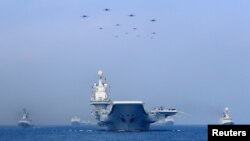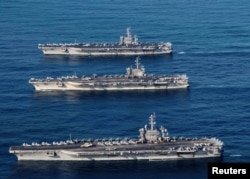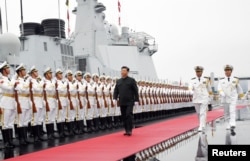A generation ago, in early 1996, China fired missiles in the waters around Taiwan as the island was preparing for its first presidential election.
The United States intervened. It deployed two aircraft carriers to guard in the Taiwan Strait area. It was the biggest show of American naval power since the Vietnam War. And it succeeded. Missile fire stopped and Taiwan held the election.
In January, Chinese President Xi Jinping again threatened force, if necessary, to regain control of Taiwan, which China considers a rebel province. Although the U.S. still supports Taiwan, the country is showing more restraint in reaction to China’s messaging.
Since last July, the U.S. Navy has sailed seven times through the Taiwan Strait. Each time, only two naval boats were involved and none were major ships such as aircraft carriers.
Chang Ching, a retired Taiwanese naval captain, is now a researcher at the Taipei-based Society for Strategic Studies. He says the Trump administration has a problem.
“They want to send smart, calibrated signals to Beijing without causing an overreaction or misunderstanding,” he explained.
In just over 20 years, China now has built one of the strongest naval forces in the world. China now guards what it calls the San Hai, or “Three Seas:” the South China Sea, East China Sea and Yellow Sea.
The National Defense Strategy Commission (NDSC) is an expert group set up by Congress to examine national defense policies. In November, the Commission released its final report.
It discussed possible results of war between China and the U.S. “Americans could face a decisive military defeat,” the group reported.
James Holmes teaches at the U.S. Naval War College. He told Reuters, “We thought China would be a great pushover for way too long, and so we let them start the naval arms race while we dawdled.”
China’s Ministry of National Defense and the U.S. Defense Department did not answer questions from Reuters.
Fast expansion of the Chinese navy
Between 2015 and 2021, China’s military budget is expected to jump 55 percent from $167.9 billion to $260.8 billion. The U.S.-China Economic and Security Review Commission says China’s navy’s share of this budget is expected to increase 82 percent, from $31.4 billion to $57.1 billion.
The Chinese navy now has about 400 warships and submarines. The U.S. Naval War College projected that it could have more than 530 warships and submarines by the year 2030.
In comparison, The U.S. Defense Department said the U.S. Navy has 288 warships and submarines at this time. The Chinese military and its leaders, however, say that while their navy has more ships, America has more powerful ones. They say America’s sea power is greater.
For example, the U.S. has 11 aircraft carriers, 88 powerful surface warships and 69 nuclear-powered submarines. China only launched its first aircraft carrier, the Liaoning, last year.
A retired Chinese naval officer spoke to Reuters on the condition that he not be identified. He said the Chinese navy is at least thirty years behind the U.S. He said “it is too early” for the United States to worry.
For now, many of China’s warships are smaller boats. But experts say the divide between China and other countries’ navies is narrowing in terms of size, quality and capability.
Admiral Harry Harris was leader of the U.S. Pacific Command. He told American lawmakers last year that China would have more big surface warships and submarines than the Russian navy by 2020. Some experts believe China could match the U.S. Navy in numbers and quality of major surface warships by 2030.
Ending China’s humiliation
In his November 2012 speech as the new leader of the Communist Party, President Xi said, “I believe that realizing the great revival of the Chinese nation is the greatest dream of the Chinese nation in modern times.”
Last spring, Xi watched a major exercise in the South China Sea. Forty-eight warships sailed in formation with the country’s first aircraft carrier, the Liaoning. The Chinese navy has since launched a second carrier that is expected to join the group this year.
The U.S. Navy and other foreign navies still sail near the Chinese mainland. But they avoid shows of force that would increase the risk of clashes with Chinese warships and submarines.
The last U.S. carrier to pass through the Taiwan Strait was the USS Kitty Hawk. Its battle group sailed there in late 2007 after being denied a port visit to Hong Kong. In recent years, the U.S. has also avoided sending carriers to the Yellow Sea between the Korean Peninsula and the Chinese mainland.
The U.S., however, continues to send aircraft carriers through the South China Sea where many nations have claims over the waters.
A large, unsinkable carrier
People with ties to the ruling Communist Party leadership say China’s new navy is defensive in nature. They say it is to protect against a hostile United States that sees China as an enemy.
The U.S. Navy is a worldwide force with operations to fight wars in the Middle East, support European allies, answer Russia’s navy, and control international shipping paths.
To do this job, the U.S. Navy has to be present in all the world’s oceans. The entire navy of China is based on its own coast.
In a conflict near the “Three Seas,” the Chinese mainland would serve as a large, unsinkable aircraft carrier. China’s warships would have the firepower of land-based missiles and aircrafts.
Most of this firepower was unavailable to China when then-U.S. President Bill Clinton deployed the two carrier battle groups off Taiwan in early 1996.
That was a turning point for China to build its modern navy.
The country is also building ships and expanding forces that in time could permit it to land on Taiwan or other disputed territories. These include the Japanese-controlled Senkaku Islands, known as the Diaoyu Islands in China.
I’m Anna Mateo. And I’m Jonathan Evans.
David Lague and Benjamin Kang Lim reported this story for Reuters. Hai Do adapted the story for Learning English. Caty Weaver was the editor.
Write to us in the Comments Section or on our Facebook page.
_______________________________________________________________
Words in This Story
calibrate - v. to measure something in an exact and precise way
pushover - n. an opponent that is easy to defeat
dawdle - v. to move or act too slowly
match - v. to be the equal or to be as good as
revival - n. the growth of something after a long period of no growth













